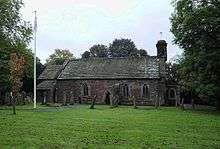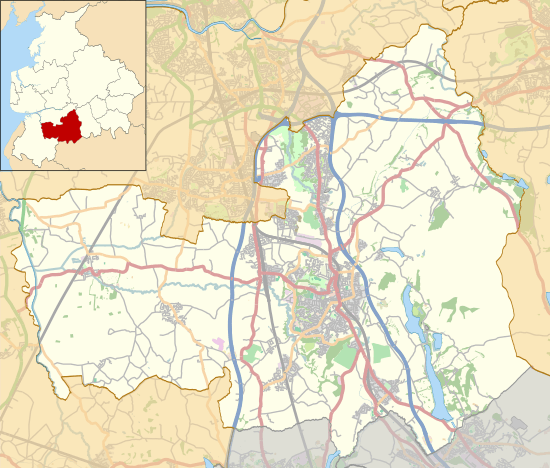Euxton Parish Church
| Euxton Parish Church | |
|---|---|
 | |
 Euxton Parish Church Location in the Borough of Chorley | |
| Coordinates: 53°40′05″N 2°40′31″W / 53.66809°N 2.67538°W | |
| Location | Euxton, Chorley, Lancashire |
| Country | England |
| Denomination | Anglican |
| Website | Euxton C of E Church, Euxton |
| Architecture | |
| Status | Parish church |
| Functional status | Active |
| Heritage designation | Grade II* |
| Architectural type | Church |
| Specifications | |
| Capacity | 191 |
| Materials | Stone, slate roofs |
| Administration | |
| Parish | Euxton |
| Deanery | Chorley |
| Archdeaconry | Blackburn |
| Diocese | Blackburn |
| Province | York |
| Clergy | |
| Vicar(s) | Revd Grant Ashton |
Euxton Parish Church is in the English village of Euxton in the borough of Chorley, Lancashire. It is an active parish church in the Diocese of Blackburn and the archdeaconry of Blackburn. It is recorded in the National Heritage List for England as a designated Grade II* listed building.[1] The church has a seating capacity of 191.[2]
History
The church probably dates from the 14th century, rebuilt about 1513 by the Molyneux family.[1] It was originally a chapel of ease to St Andrew's Church, Leyland and was used as a Roman Catholic chapel until the late 17th or early 18th century, when it was transferred to the Church of England.[1][3]
The church was originally built as a chapel for Euxton Hall and bears a date stone with the initials of one of the Molyneux family[4] who were the owners of the chapel and Euxton Hall from the 14th century.[3]
Architecture
Exterior
There is a commonality between the appearance of Euxton Parish Church and the oldest parts of neighbouring 14th-century church in Eccleston.
Having evolved from a small family chapel into a local parish church, the exterior of the church has seen several stages of modifications, the most recent being the addition of a porch, which was built at the front of the church in 1998 using a similar red sandstone taken from the barn of Eli Heaton (who had served as church verger for over 40 years[5]).
Interior
Notably, in the nave there is a double piscina and sedilia which have been dated from around the first 50 years of the 14th century.
External features
The churchyard contains the war grave of an airman of World War II.[6]
See also
References
Citations
- 1 2 3 Historic England, "Euxton Parish Church (1362144)", National Heritage List for England, retrieved 14 July 2013
- ↑ "Online Parish Clerk". http://www.lan-opc.org.uk. External link in
|publisher=(help) - 1 2 Farrer & Brownbill (1911), pp. 17–23
- ↑ "Online Parish Clerk". Euxton Council.
- ↑ "Obituary of Eli Heaton". Lancashire Lantern.
- ↑ MAHONEY, ALAN, Commonwealth War Graves Commission, retrieved 13 February 2013
Sources
- Farrer, William; Brownbill, J., eds. (1911), "Townships — Euxton", A History of the County of Lancaster: Volume 6, Constable, OCLC 619981704
External links
- Official website
 Media related to Euxton Parish Church at Wikimedia Commons
Media related to Euxton Parish Church at Wikimedia Commons